Cold War
Dir:Pawel Pawlikowski
Starring:Joann Kulig, Tomasz Kot, Borys Szyc, and Agata Kulesza
Portrayals of love and longing in film, especially good examples, always come with a hefty dose of suffering. From recent examples like Wong Kar-wai’s exemplary “In the Mood for Love” and Spike Jonze’s new age “Her” to classics like Michael Curtiz’s iconic “Casablanca” and George Cukor’s brilliant “Holiday”; love and longing and suffering can be fascinating characteristics of human nature and intoxicating insights into the complexities of romance.
Director Pawel Pawlikowski, who directed the sublime “My Summer of Love” and the solemn “Ida”, tackles a romance made complicated by politics and art. “Cold War” unfolds over the course of time, with two people who are deeply in love with each other but are forced to separate numerous times because of the world they live in.
The film begins in 1949 with a musician named Wiktor (Tomasz Kot) who is exploring the Polish countryside in search of folk music to record and recruit. The purpose of Wiktor’s efforts is to create an ensemble of artists meant to serve the purpose of the political structure instead of the culture and storytelling these folk songs infuse. This brings Wiktor into company with Zula, a singer desperate to escape her circumstances. Wiktor and Zula become instantly attracted to one another, it turns to a complicated love story that will define many years to come for the couple.
“Cold War” is composed with beautiful black and white photography, the monochrome palette pulls the rich details of the environment and adds striking contrast to many of the scenes where the long-in-love couple is separated by a world that views everything with simplistic ideals. What this photographic choice also organizes is treating the story like an old scrapbook being flipped through years after the events take place; distressed pictures of faded memories that show the smiles amongst the blurry backgrounds of a world that never stops changing, never stops threatening the happiness of people who love one another.
The fantastic character development, which amazingly takes place over the relatively short 89-minute running time, is assisted by the ferocious performances from Joann Kulig and Tomasz Kot. The actors are perfectly cast for the roles here; their chemistry is incendiary, specifically the non-verbal communication that composes the course of their changing relationship. Zula’s fading smile and Wiktor’s deep gazes are telling a completely emotional story by themselves, without any dialog or storyline to drive the messaging.
“Cold War” does so much while doing so little; it explores the consequences of a changing political structure and how it knowingly, and unknowingly, ripples transformations throughout the lives of people trying simply to survive. Director Pawel Pawlikowski crafts a romantic story that is filled with passion and pain, optimism and melancholy; however, through the journey over time, over love and loss, “Cold War” will seduce you with performance and technique. It’s suffering at its finest but also a sweeping and richly detailed vision of love.
Monte’s Rating
4.25 out of 5.00


























